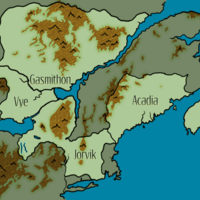Harvester Roasp
The harvester roasp is a hive-minded, scavenging insect that combines many aspects of cockroaches and wasps. They were created to gather usable materials from old waste disposal sites and the environment in general.
Each strain of roasp can sense a different kind of material and uses this to build its nest. When released on an area which contains this stuff, a swarm of roasps gathers and cleans it, then constructs a hive around the queen with it. Their hardiness means they can enter into toxic environments and bring out purified material. They do not eat their nesting matter, instead being omnivorous scavengers and opportunistic predators.
Humans keep harvester roasp colonies and move them around the wilderness, searching for old deposits of valuable material. At the start of winter, most of the drones die off, and the queens can be taken from their hives, which are then sold as raw material.
Roasp keepers are often adventurous and strange people who spend more time in the company of insects than with other humans. The boundaries of particularly large deposits are often fringed with many keeper camps. Since Hivewatchers are common targets for bandits, they often hire guards. Rich keepers with many swarms can hire them directly, but sometimes several less-powerful keepers will pool their resources to guard a claim.
A side-effect of roasp harvesting is that toxins become more concentrated in an area the more roasps are working in it, since they leave them behind. This means extracting rare materials, like gold, is more difficult and dangerous for the keepers.
Breeds of roaps include:
- Some roasp colonies build with bone or congealed blood. There are severe laws against harboring one of these colonies willingly, since they inflict great sickness on nearby communities. However, these hives can be useful for bloodwrights as a concentrated source of power.
- Most metal used in the Four Kingdoms is gathered by harvester roasps, and trade is conducted in hives instead of ingots, or slips of foil encased in clear plastics.
- Certain breeds are an important source of textiles, creating fibrous hives which can easily be unraveled and woven into coarse but warm fabric known as hivespun.
- Windows are often made from wavy leaves of glass roasp hives. Some bottles are made by fastening two of these leaves together and slicing a hole for a stopper in the top of the join.
